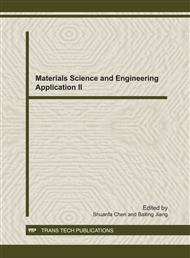p.361
p.367
p.371
p.375
p.383
p.391
p.399
p.404
p.410
Electrochemical Research on Cl- which Destroys the Surface Passivation Film of T23 in Supercritical Water Tubes
Abstract:
This article with the electrochemistry workstation, electrochemical noise, SEM, X-ray diffraction and atomic absorption spectrophotometer (AAS) has studied the corrosion behavior of Cl- which destroys the surface passivation film of T23 materials in supercritical water tubes. According to the experimental results and analysis, it can be concluded as followed: material was immersed in passivation solution for 7200S electrochemistry noise (ECN) testing, after 6000S, the potential and current tended to be stable. To unify ECN, Tafel curve and electrochemical impedance spectroscopy (EIS), it was considered that the material surface had formed passivation film. But the first 1500S noise potential and current fell rapidly in the 7200S erosion process, Tafel curve passivation area and EIS second arc disappeared, the potential and current was stable after 1500S. So the passivation film of material surface was destroyed, and Fe3O4 product gradually formed on the surface, finally the material corrosion entered into stable state.
Info:
Periodical:
Pages:
383-390
Citation:
Online since:
December 2011
Authors:
Keywords:
Price:
Сopyright:
© 2012 Trans Tech Publications Ltd. All Rights Reserved
Share:
Citation:


